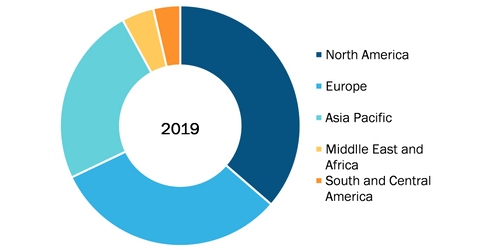According to our latest market study on "Global Organic Shrimp Market to 2027 - COVID-19 Impact and Global Analysis by Source (Cold Water, Warm Water); Species (Gulf Shrimps, Farmed Whiteleg Shrimps, Banded Coral Shrimps, Royal Red Shrimps, Others); Application (Food, Pharmaceutical, Cosmetics, Others), and Geography," the market was valued at US$ 3.40 billion in 2019 and is projected to reach US$ 6.16 billion by 2027; it is expected to grow at a CAGR of 7.7% from 2020 to 2027.
The organic shrimp market is broadly segmented into five major regions—North America, Europe, APAC, MEA, and SAM. Increasing awareness regarding the organic food products and nutritional profile of seafood are the major factors supporting the global organic shrimp market growth. The market is fragmented one, with a large number of well-established global players that have a broad geographic reach and well-diversified product offerings. Moreover, the market also includes several regional players with limited geographic focus.
APAC holds the largest share of the global organic shrimp market owing to growing awareness regarding the health benefits of organic shrimps. Countries such as Bangladesh, India, Vietnam, Malaysia, Indonesia, and the Philippines are the key exporters of organic shrimp globally. Supportive government initiatives contribute significantly to the growth of the organic shrimp market in this these countries. APAC accounted for more than 50% of the total market in 2019. The global organic shrimp market players have an opportunity to expand their presence in APAC to achieve a significant market share.
The organic shrimp market, by application, is segmented into food, pharmaceuticals, cosmetics, and others. The food segment is expected to dominate the organic shrimp market during the forecast period. The dominance of the food industry among the major applications of organics shrimps is attributed to its extensive popularity among sea food category and consumption in numerous cultures. Shrimps are offered in either a fresh form or a frozen form, and are extensively popular among sushi restaurants. In retail food industry, the frozen shrimps are the most commonly available form of the products throughout the year. Owing to their extensive rich nutrients, proteins and low-calorie value their have gained unprecedented popularity among different food industries in various countries.
Impact of COVID-19 on Organic Shrimp market
The organic shrimp market in APAC has witnessed a mixed impact of the COVID-19 outbreak. For instance, India witnessed a decline in the demand for wet market-based goods and products resulting in the decline in the shrimp prices owing to limited exporting opportunities. Whereas, the Indonesian market hardly witnessed any impact in the demand for shrimps and the prices fell sharply owing to the abundant supply as the international exporting plummeted. China, which has emerged as the second-largest importer of shrimp after the US, also witnessed negligible decline in demand for shrimps following the pandemic. However, the country did impose import restriction on shrimps exported by selected Latin American countries due to detection of the virus in imported shrimps.
Organic Shrimp Market - Geographic Breakdown, 2019

Organic Shrimp Market to Grow at a CAGR of 7.7% to reach US$ 6.16 Billion from 2020 to 2027
Download Free Sample
Organic Shrimp Market Forecast to 2027 - COVID-19 Impact and Global Analysis by Source (Cold Water, Warm Water), Species (Gulf Shrimps, Farmed Whiteleg Shrimps, Banded Coral Shrimps, Royal Red Shrimps, Others), Application (Food, Pharmaceutical, Cosmetics, Others)
Organic Shrimp Market to Grow at a CAGR of 7.7% to reach US$ 6.16 Billion from 2020 to 2027
Download Free SampleOrganic Shrimp Market Forecast to 2027 - COVID-19 Impact and Global Analysis by Source (Cold Water, Warm Water), Species (Gulf Shrimps, Farmed Whiteleg Shrimps, Banded Coral Shrimps, Royal Red Shrimps, Others), Application (Food, Pharmaceutical, Cosmetics, Others)
The report segments the global organic shrimp market as follows:
By Source
- Cold Water
- Warm Water
By Application
- Food
- Pharmaceutical
- Cosmetics
- Others
- North America
- US
- Canada
- Mexico
- Europe
- France
- Germany
- Italy
- UK
- Russia
- Rest of Europe
- Asia Pacific (APAC)
- China
- India
- South Korea
- Japan
- Australia
- Rest of APAC
- Middle East and Africa (MEA)
- Saudi Arabia
- UAE
- South Africa
- Rest of MEA
- South America (SAM)
- Brazil
- Argentina
- Rest of SAM